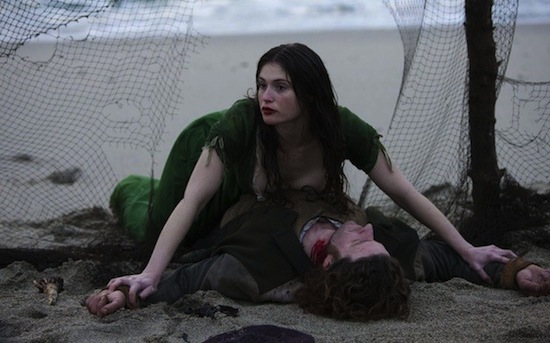Describing Neil Jordan’s new film, Byzantium in terms of its parallels to his 1994 adaptation of Anne Rice’s Interview With The Vampire may be a cheap, obvious trick, but his decision to return to the subject matter almost 20 years later is worth investigating. Byzantium has a lot more in common with Interview With The Vampire than it does with the slew of vampire films and TV series that have appeared in the intervening decades, concerned as they so often are with romantic love, nobility, and notions of the soul. Jordan has ignored all that and returned to the organic, animalistic vampire of 18th and 19th-century Gothic fiction, the kind that Interview With The Vampire was all about.
Byzantium tells the story of Clara (Gemma Arterton) and her daughter Eleanor (Saoirse Ronan), who are forced to run from their past, but fetch up in a dilapidated coastal resort and find themselves closer to their origins than ever. The setting then is English not American and, most obviously, the undead protagonists are both female. Clara and Eleanor are like the quieter vampires of Polidori and le Fanu, writers whose stories preceded Bram Stoker’s Dracula and the Hammer Horror vampires we’re used to today with their bats and dust and drama. Instead, they cut to the heart of what Gothic fiction is really all about – the rites of passage from mystery to knowledge.
Writer Moira Buffini, who adapted the script from her own play, describes it as being about damage – the kind that would result from having to spend 200 years with your mother – and also about women and the men who serve them. Their relationships with their victims are complex, not always one-way. Men aren’t just food, they’re sources of money, shelter, self-esteem. They’re also threats – a fraternity hunts the two women for usurping knowledge reserved for men. Vampirism in fiction is an endlessly mutable metaphor, and Byzantium explores it interestingly. Here, the infection isn’t physical, it’s metaphysical. Becoming a vampire is separated from the intimacy of blood-drinking and killing and removed to a ritual in a hidden cave, like that of an ancient mystery cult. Vampires, as initiates, must live by a code and create no others; in fact, curiosity’s the infection that leads to death.
This particular interpretation of the Gothic aesthetic is bang up to the minute, and Buffini is a central figure – she wrote the screenplays for Posy Simmonds’ Thomas Hardy-inspired Tamara Drewe (Stephen Frears, 2010) and the recent adaptation of Jane Eyre (Cary Fukunaga, 2011) starring Mia Wasikowska. In atmosphere, though, Byzantium is perhaps most reminiscent of Wasikowska’s latest film, Stoker (Park Chan-wook, 2013). Like Wasikowska’s India, Saoirse Ronan’s Eleanor is the serious, clever, slightly plainer daughter of a glamorous, flighty, beautiful mother, and the pressure of being in her shadow when it comes to sexual attractiveness whilst also being her superior intellectually – a reversal of the expected order – has terribly unhappy consequences. Both films have a slightly warped sense of period, too: the sense of a modern setting with an old-fashioned tinge to it, as if there had been mobile phones in the mid-20th century.
Aesthetically contemporary it may be, but were Jordan and long-term collaborator and producer Stephen Woolley right to return to Gothic vampire territory? Frankly, Byzantium is a gorgeous mess. The narrative is structured as a series of lovely and brutal vignettes, all strung together like beads. There is charm in the way the ugliness of the resort is photographed as carefully and beautifully as the contrasting, gloriously over-the-top natural settings. And with such accomplished photography and within such a fractured narrative, there is plenty of room for elaborate meanings to suggest themselves. Buffini’s script has the peculiarly elegiac, plangent sense of mystery, wonder and romance that, nowadays, perhaps only young adult fiction (her source play, A Vampire Story, was written for teenagers) can really get away with adopting uncritically. It’s told well enough – the threads of the story wind tighter and tighter together as the film goes on, and to its credit it never once feels like a film of a play – but the rich imagery has a strangeness that suggests a rather Victorian, romantic sentimentality, with the superficiality that often implies.
Ronan, as always, turns in a great performance, subtle and accomplished. She’s noticeably grown up, but she retains that open innocence from Joe Wright’s Atonement (2007) and Hanna (2011). Arterton gets more beautiful with every role, but her ‘tart-wiv-an-‘eart’ act here is hollow and unsatisfying. The presence of Daniel Mays as Noel, the depressed owner of the Byzantium guesthouse that offers Clara and Eleanor refuge, lends his scenes an unfortunate British-sitcom resonance.
Producer Elizabeth Karlsen describes Interview With The Vampire and Byzantium as the second and third parts of a trilogy, with Jordan’s 1984 version of Angela Carter’s werewolf story The Company of Wolves being the first. It’s important that all three films were written or co-written by the (female) authors of the original texts. Carter’s concern with distilling Perrault’s traditional stories to get at their meaning is perhaps similar to what Jordan and Buffini are trying to do with 18th and 19th-century Gothic fiction, The twist here is that they’re also doing it with Jordan’s previous Gothic fantasies. You can’t help but be interested in the result. But like so many of Neil Jordan’s films, Byzantium is ultimately a curiosity, a curate’s egg in which the good parts are fascinating, lyrical and rich, but which somehow adds up to something less than the sum of those parts.


